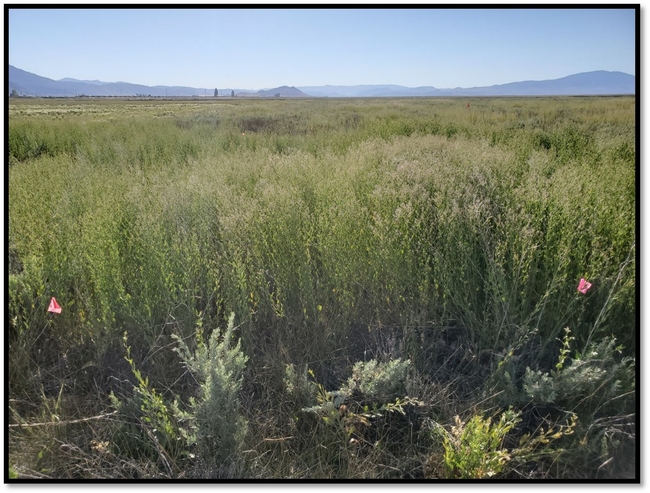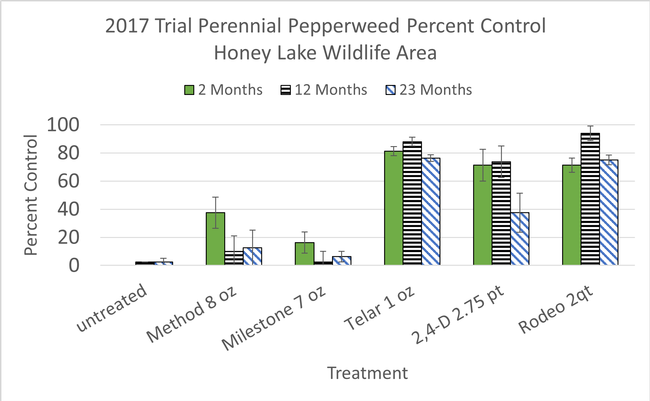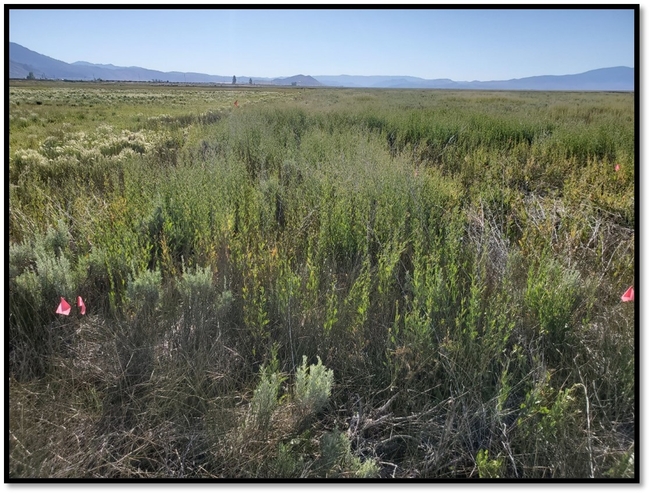A few months ago Rob Wilson wrote an excellent blog highlighting perennial pepperweed patches he was seeing in the Klamath Basin. It is a terrible noxious weed, which is found throughout much of the state, from sea level up to 8,000 ft. in the Sierras.
Where I live in the Honey Lake Valley, perennial pepperweed is widespread and has completely overtaken vast acreages of unmanaged pastures and riparian areas. At one point, it was estimated around 64,000 acres of land were infested throughout Lassen county. Generally, the Honey Lake Valley and Long Valley are hotspots that contain the majority of the acreage. While I live in the Honey Lake Valley, I also travel and work in many other valleys throughout northeastern California. I have found the perennial pepperweed population where I live is infamous. Ranchers and land managers see what a problem pepperweed has become in the Honey Lake Valley and want to keep it out of the numerous other valleys where it is not established.
Pepperweed in the Honey Lake Valley
One of these areas is Sierra Valley south on highway 395 and east on highway 70 over Beckwourth Pass. While there are isolated pockets of pepperweed which exist in Sierra Valley, ranchers and land managers have been vigilant to control it as the last thing they want is for their mountain valley to be overtaken like the Honey Lake Valley.
While perennial pepperweed can be a very difficult species to control, there has been a tremendous amount of research investigating the best ways to manage it on the landscape (James Young and Mark Renz and Rob Wilson to name a few). Often a combination of herbicides and physical techniques are utilized to target the deep, extensive, tuberous root system. Generally, herbicides such as glyphosate, 2,4-D and chlorsulfuron (Telar) have been shown to be effective. Both 2,4-D and Telar are generally selective, and can be applied relatively safely to perennial grasses in established pasture. Telar has soil residual activity, and in research done years ago by Wilson and Renz has shown it to offer better multiyear suppression compared to 2,4-D. Some of my more recent trials in the Honey Lake Valley have replicated what the previous research has shown (Figure one).
Figure One: Pepperweed control from a trial in the Honey Lake Valley
A couple of years ago, I was approached by a land manager in Sierra Valley who had been applying Telar to his pepperweed population with limited success. Initially, I assumed that something probably wasn't being done quite right. Maybe the application timing was off? or maybe they were not properly calibrating their sprayers? I met with the land manager and we walked though his calibration methods, and I double checked his math. Everything seemed to be in order. We even tested the well water, and it also appeared to be fine quality.
As I couldn't find anything on the surface, I figured it would be worth putting out a small replicated field trial to investigate his lack of control. The pepperweed patches on site were small, and one of the largest ones only had room for 5 treatments replicated 3 times. We tried two rates of Telar, MSO and NIS at the high rate, and 2,4-D as standard. Pompously, I expected that my applications of Telar would work, but I couldn't have been more wrong!
Looking at the treatments one year after application, I was only getting suppression, not control with any of the Telar applications (20-40%). The plants were stunted, but not controlled (Figure two). Where 2,4-D looked as expected one year after application with about 80% control. Typically 2,4-D gives a good burn down of pepperweed, but the plants start to come back after 1 year, where multiple years of 2,4-D have been shown to be quite effective.
Photo one: Untreated check 12.5 months after treatment at property in Sierra Valley. Plants are alive and well in full bud/bloom stage.
Photo two: Telar 2.6 oz. MSO 12.5 months after treatment in Sierra Valley. Plants are stunted but very much alive and actively growing (35% control).
Photo three: 2,4-D 2 qt. MSO 12.5 months after treatment in Sierra Valley. Plants are stunted and chlorotic, stand is greatly reduced (80% control).
This was confusing to me, and not what I expected: Telar was not effective in my Sierra Valley plots. The land manager was really quite happy with the results of the small plots, as he had been second-guessing himself as to why his applications did not work. The lack of success I saw confirmed what he had been seeing over the past decade with limited effectiveness of Telar for his perennial pepperweed. These results did not reflect results I had seen over on the other side of the hill in the Honey Lake Valley, nor did the results reflect what other research had shown throughout other portions of the west.
Figure two: Pepperweed control from the Sierra Valley Site
But, what was happening? Why wasn't the Telar working?
Generally, the USGS soil survey classified the location as a Remelli clay. It is an area that is not well drained and often sees flooding in the winter. There were Juncus species, perennial grasses, and silver sage also present on the site. I pulled some soil samples on the site to see if there might be some explanation. When the soil samples came back from the lab, they indicated the site had 11% OM and a pH of 6.8. This was nearly double the OM of the research site from in the Honey Lake Valley in 2017, which had a much lower OM and higher pH (6.2% OM and pH 8.6).
Could the unique soil be to blame for the lack of effectiveness of the Telar? Looking at the chemical properties of Telar, I think the soil characteristics could be a contributing factor.
Telar has a moderate affinity for OM, and is considered to absorb to the soil more at a lower pH. Additionally, Telar is broken down by microbial activity in soils with lower pH and adequate soil moisture, both of which were present on site. Conversely in soils with high pH (like the Honey lake site), Telar is not readily broken down by microbes and is considered more mobile in the soil binding less to OM and soil particles. My current theory is that the lack of Telar's effectiveness in Sierra Valley could be tied to the very high OM content of the soil, and lower pH affecting microbial breakdown of the herbicide.
Regardless of exactly what is limiting the effectiveness of Telar, it hasn't been working for the land manager, and didn't work in my field plots! For him, there may be a need to shift control tactics to 2,4-D or to a nonselective product like glyphosate or imazapyr to keep the pepperweed from spreading in Sierra Valley. Unfortunately, what has been effective in one place and time, is not always effective in another place and time. And the explanation to why is often not simple!



